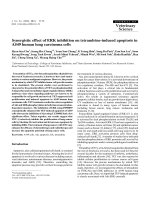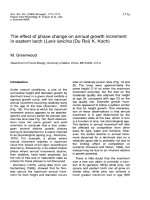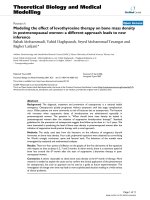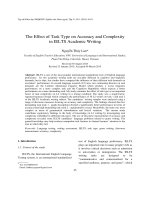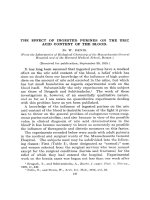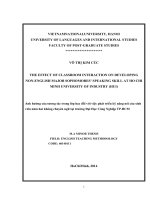Hepatoprotective effect of aqueous extract of Gyrocarpus Asiaticus on Paracetamol induced hepatotoxicity in zebra fish
Bạn đang xem bản rút gọn của tài liệu. Xem và tải ngay bản đầy đủ của tài liệu tại đây (336.62 KB, 6 trang )
Int.J.Curr.Microbiol.App.Sci (2019) 8(4): 2260-2265
International Journal of Current Microbiology and Applied Sciences
ISSN: 2319-7706 Volume 8 Number 04 (2019)
Journal homepage:
Original Research Article
/>
Hepatoprotective Effect of Aqueous Extract of Gyrocarpus asiaticus on
Paracetamol Induced Hepatotoxicity in Zebra Fish
Baisakhi Moharana1*, S.P. Preetha2, C. Balachandran3 and P. Acharya4
1
Division of Pharmacology, CSIR-CDRI, Lucknow
Department of Veterinary Pharmacology and Toxicology,
Madras Veterinary College, TANUVAS, Chennai, India
3
Vice chancellor, TANUVAS, Chennai, India
4
Division of Livestock Production and Management, NDRI, Karnal, India
2
*Corresponding author
ABSTRACT
Keywords
Paracetamol,
hepatotoxicity,
Gyrocarpus
asiaticus, zebra
fish, ALT
Article Info
Accepted:
17 March 2019
Available Online:
10 April 2019
Paracetamol induced hepatotoxicity is a common model for accessing the hepatoprotective
nature of new molecules. This study was conducted to evaluate the potential of aqueous
extract of Gyrocarpus asiaticus on paracetamol induced hepatotoxicity in zebra fish. Fish
were challenged with 20mM concentration of paracetamol followed by treatment with
aqueous extract of Gyrocarpus asiaticus. Serum was evaluated for alanine transferase
(ALT) concentration and liver samples were collected for histopathological analysis.
Result of this study showed that, there was marked elevation of ALT in induced group and
compare to paracetamol induced toxicity group, Gyrocarpus asiaticus treated group has
got marked reduction in ALT which also confirmed through histopathological analysis,
where the treatment group showed normal morphological features. Hence further study can
be done to elucidate the mechanism of action of Gyrocarpus asiaticus through molecular
level to have a confirmation of hepatoprotective nature of this plant.
Introduction
Drug induced liver injury (DILI) is a major
challenge in pharmaceutical industry and drug
development (Heidari et al., 2015). DILI due
to paracetamol overdose is dose dependant
and to an extent, predictable from the dose
ingested (Vliegenthart et al., 2014).
Marzilawatiet al., (2012) documented the
significant association of 3.8% of ethnicity
with hepatotoxicity in Indians. Therefore,
improvised models are necessary for
predicting DILI and to evaluate alternate
hepato-protective agents. The zebrafish is a
promising animal for assessing drug induced
toxicity in variety of organ systems including
liver as zebrafish metabolize drugs using
similar pathways as human (Vliegenthart et
al., 2014). N-acetylcysteine (NAC) is used as
specific antidote for paracetamol induced
poisoning but is having some adverse effects
like life threatening anaphylactic reactions
(Algren, 2008). So as an alternative, natural
product can be experimented to sort out the
probable hepato-protective effect in a dose
dependant
manner.
Among
natural
2260
Int.J.Curr.Microbiol.App.Sci (2019) 8(4): 2260-2265
compounds, silymarin is a well-known
hepatoprotective drug used for the treatment
of many liver diseases (Pradhan and Girish,
2006).
Gyrocarpus asiaticus belongs to family
Hernandiaceae and found in various parts of
India including Eastern Ghats of Tamilnadu
(Jayakumar et al., 2008). This plant is
reported to have antidiabetic (Yelchuri and
Yajaman, 2014), antibacterial (Kanthal et al.,
2014), ant helminthic (Kanthal et al., 2013)
and anticancer activities (Vithya et al., 2013).
According to the perusal of literature there are
very scanty reports on hepatoprotective
effects of this plant. Vithya et al., (2012)
reported on the free radical scavenging
activity of this plant which signifies its
antioxidant effect.
Hence keeping these criteria in mind this
research is undertaken to explore the effect of
Gyrocarpus asiaticus on paracetamol induced
hepatotoxicity.
Materials and Methods
Animals
Adult zebrafish of both sexes (Danio rerio)
were purchased from a local pet shop and
acclimated in aerated tanks containing
distilled water. Zebrafish were fed with
commercial fish food twice a day and kept at
approximately 28ºC with a 14hr: 10 hr light
dark cycle. Each zebrafish weighed 0.2-0.3g
and each ten zebrafish were treated in static
tanks filled with 2.0 litres of water.
Preparation of aqueous
Gyrocarpus asiaticus
extract
of
Stem
bark
portion
of
Gyrocarpus
asiaticuswas collected from the Azhagar
Kovil hills, Madurai District, Tamilnadu,
India. Twenty gram of powdered plant
material was taken in 200 ml conical flask
and 100 ml of water was added to it. The
mouth of the conical flask was covered with
aluminium foil and kept in a orbitals shaker
for 24 hours for continuous agitation at 150
rev/min for through mixing. Then the extract
was filtered by muslin cloth followed by
Whatman no. 1 filter paper and finally filtered
by using vacuum evaporator with the water
bath temperature of 50ºC. Finally, the
residues were collected and used for the
experiment.
Acute toxicity study
Acute toxicity test was performed following
OECD guideline no. 203. Aqueous extract of
Gyrocarpus asiaticus was dissolved in water.
Five ascending concentrations of Gyrocarpus
asiaticus aqueous extract (10, 50, 100, 500,
1000 mg/l) were used for the study. After 7
days of acclimatization, seven fish were kept
in each 4 litre glass aquarium. A total of 42
zebrafish (including control) were used in this
test. During the test fish were not fed. The test
was performed using a semistatic method
with the solutions renewed every 24 hours.
Fish condition and mortality were checked
every 24 hours. Experiment was conducted
for 96 hours. Water temperature (23 ± 0.5ºC),
pH (8.3 to 8.61) and oxygen saturation (above
60%) were monitored every 24 hours.
Experimental design
Zebrafish were exposed to paracetamol (2040mM), dissolved in system water for 3 hours
(or system water alone for negative controls)
(Fig. 1). At 40 mM concentration 80%
mortality was seen within 2 hours of exposure
and 60% of mortality at 30 Mm exposure. So
the hepatotoxicity was induced by 20Mm
concentration of paracetamol. This was
followed by a change of system water for 221 hours with or without treatment (Table 1).
This short exposure to high concentration of
2261
Int.J.Curr.Microbiol.App.Sci (2019) 8(4): 2260-2265
paracetamol followed by delayed treatment
was used to replicate a human single, acute
overdose. Experiments were terminated 5-24
hours after the start of paracetamol exposure
(Vliegenthart et al., 2014). After treatment for
24 hours, zebrafish were anaesthetized using
melting ice. Blood was collected using
established lateral incision (LI) technique.
Then fish were euthanized in melting mice.
The liver tissues were separated and used
immediately for biochemical analysis. Serum
was separated by centrifuging the blood at
2500 rpm for 15 minutes and analysed for
acute marker for cellular integrity i.e., alanine
aminotransferase (ALT) was estimated in the
serum by kinetic method using stanadard kits
(Agappe Diagostics).
Histopathology
After sacrifice, portions of the liver were
collected and fixed in neutral buffer formalin
(NBF) for histopathological examination.
Sections were cut at 5 µm thickness, stained
with haematoxylin and eosin (H & E). The
sections were then viewed under light
microscope for histopathoogical analysis.
Statistical analysis
The results were expressed as mean± standard
error (SE). The differences between groups
were determined by using the statistical
package for social sciences (SPSS) software
package for windows. The effects of
treatments were determined by analyzing the
data using one-way ANVA followed by
Duncan's multiple comparison tests. P values
< 0.05 or < 0.01 were considered as
statistically significant.
Results and Discussion
Treatment with 1000mg/ml resulted in death
of 15% fishes in that group in 96 hr toxicity
study whereas in other groups death was
invariably low. So it was suggestive of LD50
value is higher than 1000mg/ml. As per the
OECD guideline, at a limit dose 100mg/l fish
showed no mortality indicating that at 99%
confidence level, can also be concluded that
LD50 value is higher than 100mg/ml. As the
dosing is concern, 1/10th of the highest dose
tested was used as the therapeutic dose in the
study. In the present study, paracetamol
treated group showed an increase in serum
ALT activity (Fig. 2). Administration of
Gyrocarpus asiaticus revealed a decrease in
serum ALT activity up to normal level, which
is similar to that of the standard drug
silymarin at the given dose. As per
histopathology reports, untreated zebrafish
liver showed normal tissue and cell structure,
tight cell contact and liver was filled with
polygonal
cells
with
well-preserved
cytoplasm and prominent nucleus (Fig. 3A.).
Paracetamol treatment increased vacuolar
degeneration, hepatocyte necrosis and area of
focal congestion and haemorrhage (Fig. 3B).
As demonstrated in the Figure 3B1,
paracetamol treated liver shows loose cell-tocell contact with dissociated and irregular
cells with various grades of small and large
vacuoles and amount of hepatic parenchyma
decreased.
Table.1 Experimental design
GROUPS
I
II
III
IV
TREATMENTS
Untreated control
Paracetamol Control
Paracetamol + Standard drug (Silymarin)
Paracetamol + Gyrocarpus asiaticus
2262
No. of fish
24
24
24
24
Int.J.Curr.Microbiol.App.Sci (2019) 8(4): 2260-2265
Fig.1 Zebrafish and its liver after induction with hepatotoxicity
Liver- Paracetamol induced hepatotoxicity-Haemorrhage
Fig.2 Serum ALT
Histogram shows effects of paracetamol, silymarin, Gyrocarpus asiaticus (G.A) on ALT level
pooled sample of serum
Fig.3 Histopathological study of liver
A
B3
B1
B2
C
D
Histological images of adult zebrafish liver, A- control-Liver- normal, B- 1:Paracetamol-Liver loose cell-to-cell contact-diffuse,
2263
Int.J.Curr.Microbiol.App.Sci (2019) 8(4): 2260-2265
2: Vacuolar degeneration- congestion-haemorrhage, 3: Vacuolar degeneration, C- Silymarin-Liver- Mild change, D- G.A -LiverMild vacuolar degeneration
Treatment with silymarin causes mild changes
in hepatocytes (Fig. 3C) whereas treatment
with Gyrocarpus asiaticus caused vacuolar
degeneration with mild congestion (Fig. 3D).
For patients presenting with paracetamolinduced liver failure, the only reliable
parameters to provide therapeutic guidance is
ALT serum level. North et al., (2010) and
Shivashri et al., (2013) also found an increase
in ALT value in paracetamol induced
hepatotoxicity in zebra fish.
Increase in ALT activity in blood of
paracetamol-exposed fish reveals paracetamol
induced liver tissue damage. ALT and AST
are two mitochondrial enzymes (Gharaei et
al., 2011) and are found in the cell cytoplasm
in higher concentrations particularly ALT.
Higher levels of these intracellular enzymes
in serum might be a result of leakage from
cells due to cell membrane damage.
As per histopathology is concern Gyrocarpus
asiaticus could able to decrease the
inflammatory lesions, but not completely
restore the normal architecture of liver. As it
was an acute study, for reverting back from
degenerative state to normal state needs time
and treatment for longer period could have
restore the architecture of liver to normal state
in zebra fish. However, the liver histology
was comparatively improved and shown less
congestion than paracetamol toxicity group.
Hence in conclusion, zebrafish acts as a
physiologically
relevant
model
of
paracetamol hepatotoxicity. Here, we use a
variety of biochemical, histological, and
clinical outcome measures to show the overall
relevance of the zebrafish paracetamol
toxicity model to human physiology. Further
study can be performed with molecular
pathway analysis to unravel the potential of
Gyrocarpus asiaticus in hepatotoxicity model
with variable doses.
Acknowledgement
This work was funded by Tamilnadu
Veterinary and Animal Sciences University
and research was carried out during PhD of
the first author in Dept of Veterinary
Pharmacology and Toxicology. Our sincerely
thanks to Dr. S. Vairamuthu, Associate
Professor and Head, Centralized Clinical
Laboratory, Madras Veterinary College, for
his kind help in carrying out the biochemical
and hematological study. Also, I want to
acknowledge Dr. M. R. Srinivasan for guiding
me in related to procurement and maintained
of Zebrafish in laboratory conditions.
References
Algren, DA., Review of N-Acetylcysteine for
the treatment of acetaminophen
(Paracetamol) toxicity in pediatrics.
Second meeting of the subcommittee
of the expert committee on the
selection and use of essential
medicines, 2008.
Gharaei, A., Ghaffari M, Keyvanshokooh S,
Akrami R. Changes in metabolic
enzymes, cortisol and glucose
concentrations of Beluga (Huso huso)
exposed to dietary methyl mercury.
Fish Physiol Biochem 2011; 37:485–
493.
Heidari R, Niknahad H, Jamshidzadeh A, M.
AE, Abdoli N. An overview on the
proposed mechanisms of antithyroid
drugs-induced liver injury. Adv.
Pharm Bull. 2015; 5: 1-11.
Jayakumar, S., Ramachandran A, Bhaskaran
G, Heo J. Forest dynamics in the
Eastern Ghats of Tamilnadu, India.
Environmental Management. 2008;
DOI 10.1007/s00267-008-9219-y.
Kanthal ,LK., Dey A, Satyavathi K, Bhojaraju
P.
Antibacterial
potential
of
2264
Int.J.Curr.Microbiol.App.Sci (2019) 8(4): 2260-2265
methanolic extract of Gyrocarpus
asiaticus wild. Asian J. Pharm Clin
Res 2014; 7: 192-194.
Kanthal, L.K., A. Dey, K. Satyavathi, P.
Bhojaraju, 2013. Evaluation of
anthelmitic activity of Gyrocarpus
asiaticus wild and Lacuta runcinata
DC on the pheritima model. Int J.
Pharm Pharm Sci.5: 273-275.
Marzilawati, AR., YY Ngau and Mahadeva S.
Low rates of hepatotoxicity among
Asian patients with paracetamol
overdose: a review of 2014 cases.
BMC
Phamacologyandtoxicology.
2012;13:
m/bmcpharmacoltoxicol
/20506511/13/1/8.
North, TE, Babu IR, Trista EL, Vedder M,
Lord AM, Wishnok JS, Tannenbaum
SR, Leonard IZ, Wolfram G. PGE2regulated wnt signaling and Nacetylcysteine are synergistically
hepatoprotective
in
zebrafish
acetaminophen injury. PNAS 2010;
107: 17315–17320.
OECD GUIDELINE FOR TESTING OF
CHEMICALS-203-Fish,
Acute
Toxicity Test. Adopted: 17.07.92
Adopted by the Council on 17th July
1992.
Pradhan, SC., and Girish C. Hepatoprotective
herbal
drug,
silymarin
from
experimental pharmacology to clinical
medicine. Indian J Med Res., 2006;
124: 491.
Shivashri, C., Rajarajeshwari T and Rajasekar
P. Hepatoprotective action of celery
(Apium
graveolens)
leaves
in
acetaminophen-fed freshwater fish
(Pangasius sutchi). Fish Physiol
Biochem 2013; DOI 10.1007/s10695012-9762-6.
Vithya, T., Kavimani S, Rajkapoor B.
Anticancer activity of Gyrocarpus
asiaticus and Sophora interrupta on
daltons
lymphomaascites
(DLA)
induced mice. WJPPS. 2013; 2: 66136618.
Vithya, T., V. Kavimani, B. Rajkapoor, K.
Alhasjajiju, J.L enojenita, 2012. Free
radical
scavenging
activity of
Gyrocarpus asiaticus by using DPPH
and ABTS method. IJPCBS. 2: 155158.
Vliegenthart, ADB, Tucker CS, Pozo JD and
Dear JW. Zebrafish as model
organisms for studying drug induced
liver injury. Br J Clin Pharmacol
2014; 78: 1217-1227.
Yelchuri, P., and Yajaman S., Assessment of
antidiabetic activity of ethanolic
extracts of Gyrocarpus asiaticus wild
bark against streptozocin induced
diabetes in rats. IJAPBC 2014; 3: 6071.
How to cite this article:
Baisakhi Moharana, S.P. Preetha, C. Balachandran, Acharya, P. 2019. Hepatoprotective Effect
of Aqueous Extract of Gyrocarpus asiaticus on Paracetamol Induced Hepatotoxicity in Zebra
Fish. Int.J.Curr.Microbiol.App.Sci. 8(04): 2260-2265.
doi: />
2265

